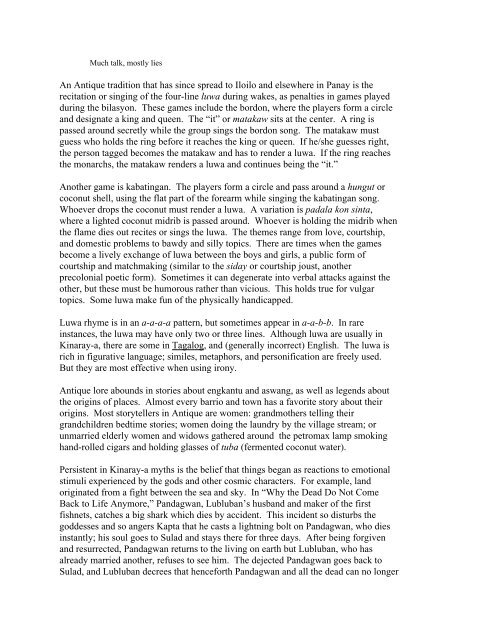Kinaray-a
Kinaray-a
Kinaray-a
Create successful ePaper yourself
Turn your PDF publications into a flip-book with our unique Google optimized e-Paper software.
Much talk, mostly lies<br />
An Antique tradition that has since spread to Iloilo and elsewhere in Panay is the<br />
recitation or singing of the four-line luwa during wakes, as penalties in games played<br />
during the bilasyon. These games include the bordon, where the players form a circle<br />
and designate a king and queen. The “it” or matakaw sits at the center. A ring is<br />
passed around secretly while the group sings the bordon song. The matakaw must<br />
guess who holds the ring before it reaches the king or queen. If he/she guesses right,<br />
the person tagged becomes the matakaw and has to render a luwa. If the ring reaches<br />
the monarchs, the matakaw renders a luwa and continues being the “it.”<br />
Another game is kabatingan. The players form a circle and pass around a hungut or<br />
coconut shell, using the flat part of the forearm while singing the kabatingan song.<br />
Whoever drops the coconut must render a luwa. A variation is padala kon sinta,<br />
where a lighted coconut midrib is passed around. Whoever is holding the midrib when<br />
the flame dies out recites or sings the luwa. The themes range from love, courtship,<br />
and domestic problems to bawdy and silly topics. There are times when the games<br />
become a lively exchange of luwa between the boys and girls, a public form of<br />
courtship and matchmaking (similar to the siday or courtship joust, another<br />
precolonial poetic form). Sometimes it can degenerate into verbal attacks against the<br />
other, but these must be humorous rather than vicious. This holds true for vulgar<br />
topics. Some luwa make fun of the physically handicapped.<br />
Luwa rhyme is in an a-a-a-a pattern, but sometimes appear in a-a-b-b. In rare<br />
instances, the luwa may have only two or three lines. Although luwa are usually in<br />
<strong>Kinaray</strong>-a, there are some in Tagalog, and (generally incorrect) English. The luwa is<br />
rich in figurative language; similes, metaphors, and personification are freely used.<br />
But they are most effective when using irony.<br />
Antique lore abounds in stories about engkantu and aswang, as well as legends about<br />
the origins of places. Almost every barrio and town has a favorite story about their<br />
origins. Most storytellers in Antique are women: grandmothers telling their<br />
grandchildren bedtime stories; women doing the laundry by the village stream; or<br />
unmarried elderly women and widows gathered around the petromax lamp smoking<br />
hand-rolled cigars and holding glasses of tuba (fermented coconut water).<br />
Persistent in <strong>Kinaray</strong>-a myths is the belief that things began as reactions to emotional<br />
stimuli experienced by the gods and other cosmic characters. For example, land<br />
originated from a fight between the sea and sky. In “Why the Dead Do Not Come<br />
Back to Life Anymore,” Pandagwan, Lubluban’s husband and maker of the first<br />
fishnets, catches a big shark which dies by accident. This incident so disturbs the<br />
goddesses and so angers Kapta that he casts a lightning bolt on Pandagwan, who dies<br />
instantly; his soul goes to Sulad and stays there for three days. After being forgiven<br />
and resurrected, Pandagwan returns to the living on earth but Lubluban, who has<br />
already married another, refuses to see him. The dejected Pandagwan goes back to<br />
Sulad, and Lubluban decrees that henceforth Pandagwan and all the dead can no longer
















